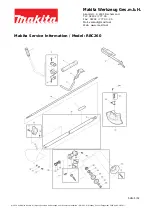
25
NI
IE
Cutting techniques using the
hedge trimmer
• Cut thick branches beforehand using a
branch clippers.
• The double-sided cutter bar enables
cutting in both directions or, with a
swinging action, from one side to the
other.
• In case of vertical cutting, move the
hedge trimmer uniformly forward or up
and down in an arc movement.
• In case of horizontal cutting, move
the hedge trimmer in a sickle-shaped
movement to the edge of the hedge, so
that cut branches fall to the ground.
• In order to achieve long straight lines,
the placing of tensioned guiding cords
is recommended.
Cutting Shaped Hedges:
It is recommended that hedges be cut in
a trapezoidal shape, in order to prevent
stripping off of the lower branches. This cor-
responds to the natural plant growth and
allows the hedge to thrive optimally. During
cutting, only the new annual growths are
reduced and thus a dense branching and a
good screen will develop.
1. Cut the sides of a hedge first. To do
this, move the hedge trimmer in the
direction of growth from bottom to top.
If you cut down from the top, the thin-
ner branches will move out, which may
result in some areas having sparse
growth or holes.
2. Cut the top edge, according to taste,
in a flat shape, roof shape or rounded
shape
3. Trim young plants to the required
shape. The main growth should re-
main undamaged until the hedge has
reached the planned height. All other
shoots are lopped off to half size.
Care of Free-Growing Hedges:
Free-growing hedges are not shaped
when cut, although they must be regularly
maintained so the hedge does not become
too high.
Cutting techniques using the
pole-mounted pruner
Be aware of the risk of kick-
back as well as falling branches
and branches on the ground.
•
Sawing off small branches:
Place the locating surface of the saw
against the branch in order to prevent
jerky movements of the saw when you
begin to cut it. Guide the saw with
light pressure from the top to the bot-
tom through the branch.
Watch out for premature breakage of
the branch if you have misjudged the
size and weight.
•
Sawing off larger branches:
In the case of larger branches, select
a relief cut first of all to ensure that the
sawing process is controlled. To do
this, saw an incision
(a)
into the bot-
tom third of the branch (with the upper
side of the blade). Then saw from top
to bottom towards the first cut (with the
underside of the blade)
(b).
Summary of Contents for PKGA 40-Li A1
Page 3: ...3 A 1 11 12 13 14 17 16 15 2 2 18 21 22 23 24 28 29 30 31 27 25 26 20 19 2 3 4 5 6 8 7 9 10 ...
Page 4: ...4 E D 2 4 33 39 42 40 41 34 38 62 4 32 3 1 23 35 36 44 43 45 37 8 7 5 B C 23 21 ...
Page 69: ...46 6 4 48 47 20 9 22 24 14 50 51 49 2 57 57 58 59 59 17 21 ...
Page 70: ...14 17 22 52 53 53 15 14 63 56 60 61 61 54 55 52 22 14 23 Rope Winding 64 65 ...
Page 71: ......
Page 75: ...1 2 3 4 5 5 4 6 4 ...
Page 95: ...23 ...
















































